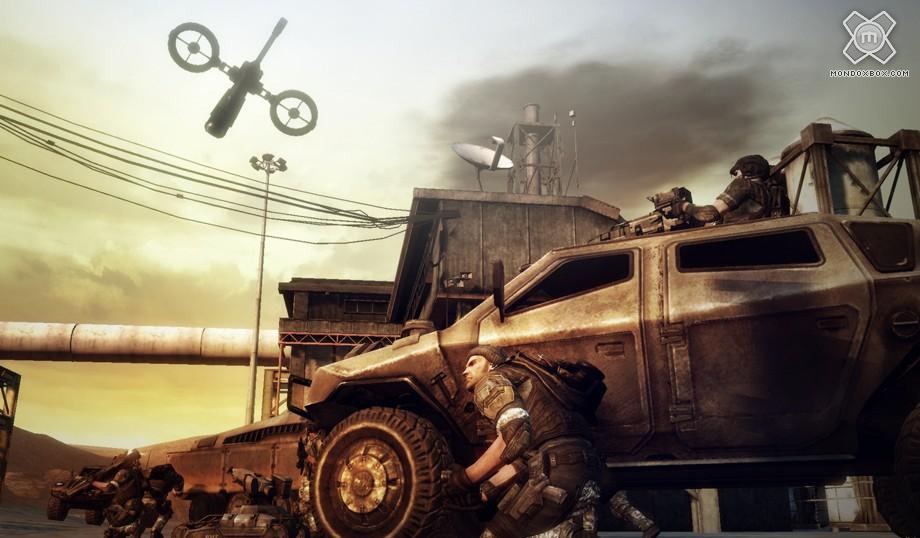›
LIVE NOW!
Frontlines: Fuel of War - intervista a Kaos Studios

Se l'arrivo sul Marketplace delle demo singleplayer e multiplayer di Frontlines: Fuel of War non fosse bastato a soddisfare le vostre curiosità su questo interessante titolo di THQ, grazie ad Xbox Community Network vi proponiamo oggi una lunga intervista in inglese agli sviluppatori del gioco, che ci rivelano molti degli aspetti legati alla sua realizzazione.
XCN: Sound is very important in your game. How did you come up with your innovative sound design concept?
Matt Harwood: Innovations are usually things that everybody says. "Hey I could have thought of that" but they don't. A simple concept that if developed in an elegant way really sounds out. The level of distance (LOD) and delay of sound is that innovation. The basic premise stems from the question "What does sound do in a natural environment", and further "How can we make that fun" the answer is in 2 parts.
1st the speed of sound - When you see the flash of an explosion in the distance, you will not hear it right away. There is a delay based on distance, the farther away, the longer the delay. We originally did the math at 769mph or 1128ft/s (the speed of sound). You would be surprised how long of a delay at such short distances this math provides. So we speed up the delay system so you can hear the audio sooner and get the feedback, it is definitely noticeable and very fun.
2nd – the LOD system, or the alteration of sound based on distance. Each weapon and vehicle weapon (some vehicle engines - jets and helicopters) and explosions has unique sounds based on the distance and location from the player. Take a weapon for example. When firing from your perspective (in the first person), you hear a fat, stereo-widened image of the sound. This sound has the most detail and clarity. When you are close to the weapon firing (the weapon in the third person), you will hear a mono positional sound with slightly less detail then the first version. Then there is the distant sound that you hear when the weapon is fired far away from you. A good example of how this system plays out in the game is when a player gets shot by a sniper, they will usually get fragged before they hear the shot for the sniper.
Other examples are - The blast of a close tank shell, thumps at distance. The roar of the mini-gun growls with mechanized terror when close, but fizzles and beets from far away. Explosions blast with dirt and debris partials when close, and they pop and rumble at a distance.
We worked very hard to give each weapon a distinct feel and sound. If you spawn into a multiplayer match and stand there for a sec, you should be able to tell which weapon loadout the enemy is firing at you. The truly awesome result from this system, is now the entire battle field is generating the ambiance of war, naturally, produced by the players. The players are the ones creating the soundscape. You’re not only affecting the gameplay with your loadout and roll choices but are also actively changing the way the game sounds.
XCN: With Frontlines Fuel of War you have created a new IP in the FPS genre. What will make this game stand out compared to all the other shooters (especially on 360) that are on the market?
1st the speed of sound - When you see the flash of an explosion in the distance, you will not hear it right away. There is a delay based on distance, the farther away, the longer the delay. We originally did the math at 769mph or 1128ft/s (the speed of sound). You would be surprised how long of a delay at such short distances this math provides. So we speed up the delay system so you can hear the audio sooner and get the feedback, it is definitely noticeable and very fun.
2nd – the LOD system, or the alteration of sound based on distance. Each weapon and vehicle weapon (some vehicle engines - jets and helicopters) and explosions has unique sounds based on the distance and location from the player. Take a weapon for example. When firing from your perspective (in the first person), you hear a fat, stereo-widened image of the sound. This sound has the most detail and clarity. When you are close to the weapon firing (the weapon in the third person), you will hear a mono positional sound with slightly less detail then the first version. Then there is the distant sound that you hear when the weapon is fired far away from you. A good example of how this system plays out in the game is when a player gets shot by a sniper, they will usually get fragged before they hear the shot for the sniper.
Other examples are - The blast of a close tank shell, thumps at distance. The roar of the mini-gun growls with mechanized terror when close, but fizzles and beets from far away. Explosions blast with dirt and debris partials when close, and they pop and rumble at a distance.
We worked very hard to give each weapon a distinct feel and sound. If you spawn into a multiplayer match and stand there for a sec, you should be able to tell which weapon loadout the enemy is firing at you. The truly awesome result from this system, is now the entire battle field is generating the ambiance of war, naturally, produced by the players. The players are the ones creating the soundscape. You’re not only affecting the gameplay with your loadout and roll choices but are also actively changing the way the game sounds.
XCN: With Frontlines Fuel of War you have created a new IP in the FPS genre. What will make this game stand out compared to all the other shooters (especially on 360) that are on the market?
Joe Halper: The saying around Kaos is that the recipe makes the cake, and it’s the combined mix of ingredients in Frontlines that you will not be able to find in any other first person shooter out there. Frontlines contains a compelling story-driven single player experience that features open world non-linear gameplay (which is rare for an FPS these days), and it’s full of both infantry and vehicle combat with weapons that the military is prototyping for use in war 20 years from now.
In multiplayer you have an entirely new game mode that is one of the most innovative and successful parts of this game. The system centers the action so both teams are fighting in the same area of the map, keeping the intensity at an all time high. You have to play it to really believe it, but the action and the way that the game mode inherently makes teamwork occur is a huge positive of the game.
Lastly, Frontlines is completely based on weapons that real world militaries are prototyping now, which gives players the chance to use these high tech weapons and drones that would enter military use in the near future. You can fly jets and helicopters, use tanks, armored fighting vehicles, anti-aircraft vehicles, deploy turrets, call in air strikes, and use high-tech remote control drones. No other FPS gives you so many weapons at your fingertips. Most military shooters are either historic or current day, Frontlines brings you tomorrows weapons today.
In multiplayer you have an entirely new game mode that is one of the most innovative and successful parts of this game. The system centers the action so both teams are fighting in the same area of the map, keeping the intensity at an all time high. You have to play it to really believe it, but the action and the way that the game mode inherently makes teamwork occur is a huge positive of the game.
Lastly, Frontlines is completely based on weapons that real world militaries are prototyping now, which gives players the chance to use these high tech weapons and drones that would enter military use in the near future. You can fly jets and helicopters, use tanks, armored fighting vehicles, anti-aircraft vehicles, deploy turrets, call in air strikes, and use high-tech remote control drones. No other FPS gives you so many weapons at your fingertips. Most military shooters are either historic or current day, Frontlines brings you tomorrows weapons today.
XCN: In an interview with Gamespot it was said that you guys find it harder to develop for PlayStation 3 then Xbox 360. Could you tell our readers what makes coding for the latter so difficult?
Joe Halper: It was interesting how fast that particular interview started spreading all over after it was posted. I mentioned that each platform had its unique set of challenges. For the Xbox360 I would say that one challenging area was the Xbox Live 32 player multiplayer. This is a feature that makes our game really stand out on Xbox Live. One common method of hosting multiplayer games through Xbox Live is to utilize one of the Xbox360 stations as the server. Most games may max out to around 12 - 14 players before everyone starts feeling/seeing the drain during gameplay. Our goal with Frontlines was to not only make it lag free but go one even further by allowing an unthinkable 32 players in our large open worlds with over 60+ weapons and vehicles. A war of this scale with so many people will be a first for Xbox360 Live. To do this we are setting up dedicated servers around the world that people can connect into and not worry about the bandwidth issues they would see with other games. Setting up this infrastructure and giving adequate testing time was one of the most challenging aspects of development. But in the end it will all be well worth it.
XCN: Vehicles are very important in this game. Can you tell us which is your favourite and why?
Joe Halper: All vehicles in FFOW give the passenger something cool to do. From target sharing and countermeasures listed above, to remote gun pod, flares or even lock on rockets fired from co-pilot positions. If you’re using VOIP, players can communicate easily to other players in the vehicle. As you can tell it is pretty much up to the individual and their play style that determines their favourite vehicle. I have always been a big fan of attack heli’s and our flying gunships are sure to impress the fans out there.
XCN: The open nature of locations and enemies on a taken level enables players to solve problems in different ways, which ads to the replayability of Frontlines (especially in co-op). How did you come up with this design and which games have had an influenced on Frontlines?
Joe Halper: The work we did on Desert Combat was in many ways a driving force for Frontlines. The way DC filled the void for modern day military shooters at the time, is the same way Frontlines was conceived; to fill a void for near-future military shooters where players could experience the weapons that the military is prototyping now, for use on tomorrow’s battle grounds. Of course our involvement with the Battlefield series and being a part of DICE during the development of BF2 continued our role in this genre of gaming.
XCN: How many players will FoF support via Xbox Live multiplayer and why do you think that a lot of gamers will use the online-multiplayer mode?
Joe Halper: Xbox Live multiplayer will support up to 32 players online. That in itself is a big reason why gamers will want to use the online-multiplayer mode. No other title offers this level of features with the ability to play with this many people. It is going to be a blast. ?
Are there already plans for download contents, like more multiplayer maps?
Yes, additional content for the game is currently in the works and we are planning on various new maps, weapons, vehicles, and possibly game modes. Stay tuned because there will be a lot to look forward to in the future with Frontlines!
Are there already plans for download contents, like more multiplayer maps?
Yes, additional content for the game is currently in the works and we are planning on various new maps, weapons, vehicles, and possibly game modes. Stay tuned because there will be a lot to look forward to in the future with Frontlines!
XCN: Does the use of a dynamic frontline imply the possibility of breakthrough / surrounding manoeuvres?
Joe Halper: Absolutely. This gets right to the core of the design of our game, which is a series of sandbox environments where the player chooses how they want to approach every objective, and every experience is as different as the player. There are dozens of routes into and out of every situation, and the encounters are different every time.
XCN: Concerning the Drones, (how) have you managed to keep the game balance intact when it comes to combat?
Joe Halper: Drones have their own strengths and weaknesses. While very agile, they are also limited in terms of range. The drones are also susceptible to all kinds of countermeasures, like EMP blasts and have been tuned to be easily defeatable by the clever infantryman.
XCN: Given the hardware limitations of consoles, where you able to polish the graphical engine to provide a smooth framerate without compromising Vsync?
Joe Halper: We absolutely were. We have a fantastic programming staff and while there were days that we had challenges with content they were able to find solutions that helped secure a solid frame rate for our final release.
XCN: Does multiplay use a party system (like Halo3, CoD4..)?
Joe Halper: Multiplayer will offer the Frontlines game mode. This game mode does a great job of effectively keeping both teams centric to the action. Instead of having both teams spread out across the map capturing undefended points, there are 2 or 3 centralized points at a time being fought over. Once a team seizes these points in battle, their frontline will advance deeper into enemy controlled territory, and suddenly one team is on the defensive, scrambling to recover lost ground. Whenever you want to know where the action is, you just head to the frontline.
As part of it, the Roles system plays a big piece of both an individual’s strategy, as well as the strategy of your overall team. With 24 combinations of weapons and Role specializations to choose from, each team can have a great variety of soldiers on each side. Everything from Drone specialists, to deploying turrets, to calling in air strikes or disabling enemy drones and vehicles with EMP technology. The choices made by each side play a large role in which direction the frontline will be moving ;)
Our team is well known for our award winning work in previous multiplayer first person shooters and the multiplayer experience in Frontlines is some of our best work yet.
As part of it, the Roles system plays a big piece of both an individual’s strategy, as well as the strategy of your overall team. With 24 combinations of weapons and Role specializations to choose from, each team can have a great variety of soldiers on each side. Everything from Drone specialists, to deploying turrets, to calling in air strikes or disabling enemy drones and vehicles with EMP technology. The choices made by each side play a large role in which direction the frontline will be moving ;)
Our team is well known for our award winning work in previous multiplayer first person shooters and the multiplayer experience in Frontlines is some of our best work yet.
XCN: Is most of the terrain destructible?
Joe Halper: The terrain is not player malleable but destruction of the environment is a key area of focus. The destruction system in FFOW provides players the ‘satisfaction of destruction’ by allowing them to destroy parts of buildings, columns, walls, and generally things that look destroyable are. We chose not to allow razing buildings to the ground because the level flow and the gameplay of the mission is negatively affected. Instead, we’ve already found that fighting say, an urban battle in a town that looks intact when you arrive, and is littered with wreckage when you leave has been extremely satisfying.
XCN: How much average playtime is needed to get new upgrades?
Joe Halper: That depends on the role. It takes quite a bit longer to get completely leveled up on some of the more powerful roles like Air Support. It is also dependent on how the game is hosted because the speed of upgrades can be modified. We leave it up to the player to choose how they want to play and how fast they can get to the role upgrades through the duration of a match.
XCN: Gamers are going to compare this game to the Battlefield series, have you learnt anything from Digital Illusions work, and what would you say is improved or the main differences?
Joe Halper: Our core team has a lot of history with the Battlefield series and Digital Illusions. We learned a lot from not only the Battlefield series but from our experience with Desert Combat. It was all a huge inspiration for us. We did though see a lot of room for improvement. For instance, we wanted to get away from the conquest style game play which is what the Frontlines system is all about. It gets players all in the same area and really focuses the gameplay. The frontline game mechanic keeps you where the action is at. You spend less time getting to the objective and more time fighting for it. We also added a deep, character driven single player segment while maintaining the open world feel this variety of FPSs is so well known for.
XCN: What unique weapons and vehicles will players be able to use?
Joe Halper: With a combined total of over 60 vehicles and weapons in Frontlines there are so many choices available to the player. All of the weapons and vehicles in Frontlines compliment current and future military technology we have found through extensive research of what the military is currently working on.
By molding this real world technology into great gameplay elements, we end up with weapons such as remote controlled anti-infantry and anti-vehicle drones, which also let you gather recon information that you can share with your fellow teammates. The drones, as cool and unique as they are, are just a scratch at the surface of what we offer in regards to firepower to the player! You can fly helicopters or get in tanks with your teammates and spot enemy units. There are deployable weapons systems, player controlled flying gunships, counter measures systems, anti-aircraft vehicles, jets, rail guns, precision air strikes, cluster bombs… we have firepower ranging from a simple handgun to a 10-ton fuel air bomb that can be dropped on an enemy location to cause major devastation. The player will literally have a blast with all that is offered in Frontlines: Fuel of War. And you can do it all while using VOIP to communicate with people in your squad.
By molding this real world technology into great gameplay elements, we end up with weapons such as remote controlled anti-infantry and anti-vehicle drones, which also let you gather recon information that you can share with your fellow teammates. The drones, as cool and unique as they are, are just a scratch at the surface of what we offer in regards to firepower to the player! You can fly helicopters or get in tanks with your teammates and spot enemy units. There are deployable weapons systems, player controlled flying gunships, counter measures systems, anti-aircraft vehicles, jets, rail guns, precision air strikes, cluster bombs… we have firepower ranging from a simple handgun to a 10-ton fuel air bomb that can be dropped on an enemy location to cause major devastation. The player will literally have a blast with all that is offered in Frontlines: Fuel of War. And you can do it all while using VOIP to communicate with people in your squad.
XCN: Call of Duty 4 is a big hit on Xbox LIVE right now – do you think Frontlines can knock it from its pedestal?
Joe Halper: Battling it out with over 60 weapons and vehicles in a heart pounding 32 multiplayer open world online session… on an Xbox360…yeah… I think we have potential.
XCN: What are the challenges associated with having so many players in the game at once?
Joe Halper: Managing your time outside of the game because with 32 people over Xbox Live it is a hell of a lot of fun and very addictive.
MX Video - Frontlines: Fuel of War
›
 Offerte in evidenza
Offerte in evidenza
-
€ 24.99 invece di 71.00
-
€ 36.90 invece di 81.99
-
€ 35.51 invece di 74.99
-
€ 40.00 invece di 79.99
-
€ 39.98 invece di 79.99
-
€ 14.49 invece di 26.42
-
€ 45.73 invece di 79.99
-
€ 29.80 invece di 49.99
-
€ 49.99 invece di 79.99
-
€ 34.99 invece di 50.99





 Offerte in evidenza
Offerte in evidenza











Commenti